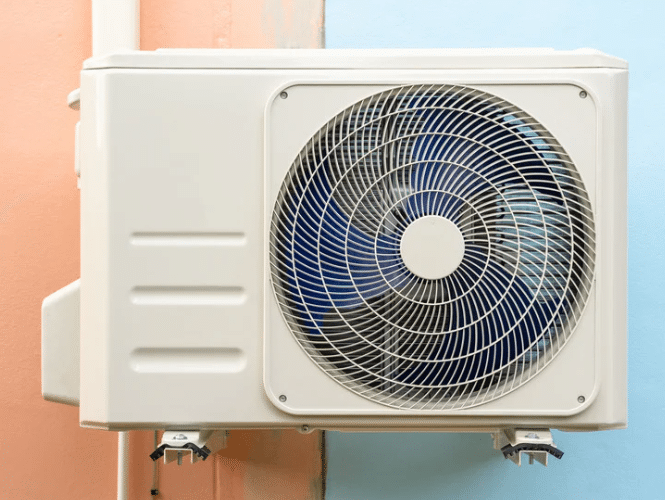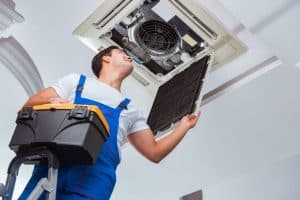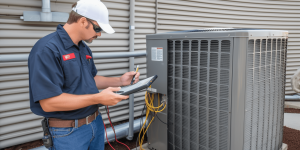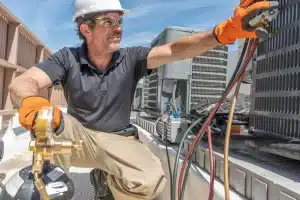When your AC fan not working, it can quickly make your home feel unbearable, especially during the hottest days of the year. An AC fan not working is more than just an inconvenience. It can be a warning sign of problems, such as electrical issues, worn-out parts, or overheating components, that require immediate attention.
This blog explains why your AC fan might fail and what you can do about it. From checking the thermostat and resetting breakers to inspecting the capacitor and motor, we’ll walk you through clear, practical steps you can follow. By the end, you’ll know how to fix basic problems or when to contact a trusted HVAC technician.
Understanding Your AC Fan System
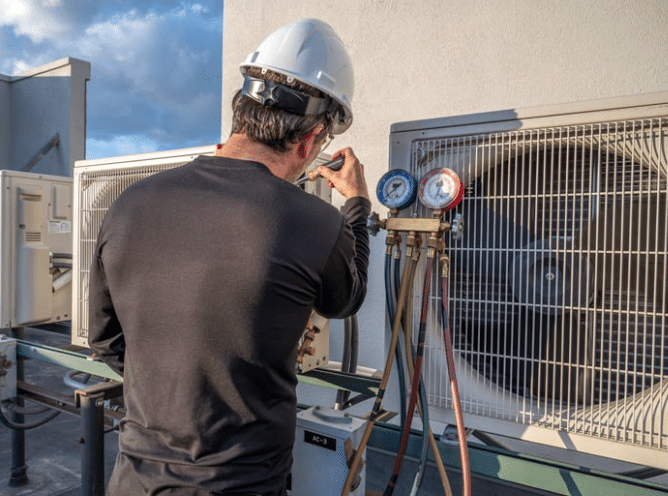
Your air conditioner relies on its fan to circulate cool air throughout your home. When the AC fan stops working, it can lead to poor airflow, uneven cooling, and higher energy bills. The fan draws in warm air, cools it, and then pushes it back through your vents to keep rooms comfortable.
There are two main fans in most systems: the blower fan and the condenser fan. The blower fan, located inside your home, circulates cool air through the ducts. The condenser fan, located outside, pushes heat away from the system. If either fan fails, your air conditioner won’t cool properly.
Understanding how these fans work can help you identify problems more quickly. If your AC is blowing warm air, making strange noises, or not turning on, fan issues could be the reason. Learning basic air conditioning fan troubleshooting steps can help you determine whether it’s a simple fix or time to call a technician.
Common Causes of Why an AC Fan Not Working
There are several reasons why an AC fan might not be working, ranging from simple issues to more complex mechanical failures. Recognizing these potential causes can help in diagnosing the problem quickly and accurately.
-
- Power Supply Issues: A tripped breaker, blown fuse, or loose wire can cut power to the fan. Always check the power supply first during troubleshooting.
-
- Thermostat Problems: Incorrect settings or a faulty thermostat can stop your fan from starting. Ensure it’s set to cooling mode and properly connected to your air conditioning system.
-
- Motor Malfunctions: A worn-out or faulty fan motor can prevent the system from functioning correctly. If the motor fails, the fan won’t spin or push air properly.
Understanding these common causes can guide you in taking the proper steps to address the issue, potentially saving time and money on unnecessary repairs.
Troubleshooting Steps for the AC Fan Not Working
Before diving into complex AC repairs, start with some basic troubleshooting steps that can often resolve the issue of an AC fan not working. These steps are simple and can be done without professional assistance.
Step 1. Check the Power Supply
Confirm that your air conditioner has power. Check the circuit breaker and reset it if it has been switched off. Additionally, inspect the power cord and connections for any visible damage.
Step 2. Examine the Thermostat
Verify that the thermostat is set to the right temperature and operating mode for cooling. Sometimes, simply adjusting the settings can resolve the issue. Also, check if the thermostat’s batteries need to be replaced.
Step 3. Inspect the Fan Blades
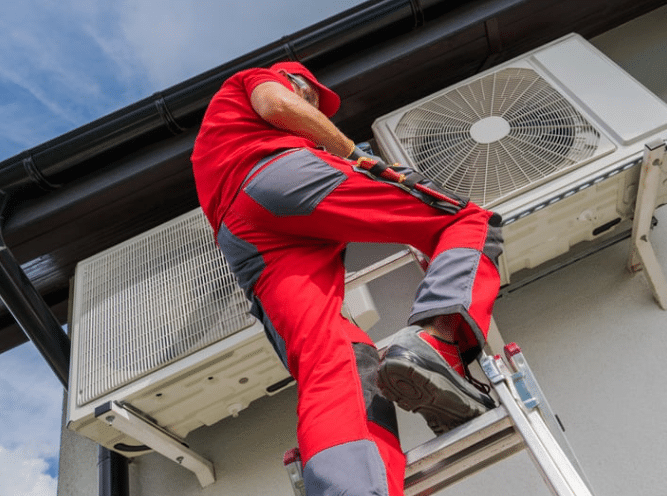
Turn off the power and manually inspect the fan blades for any obstructions or debris that might be preventing them from spinning. Clearing the blades can sometimes solve the problem.
These initial steps can quickly determine if the issue is minor and easily fixable or if further investigation is needed to address more complex problems.
Electrical Issues Affecting the AC Fan
Electrical problems are a common cause of an AC fan not working. These issues can range from simple wiring problems to more complex electrical failures within the system.
Faulty Wiring
Loose or damaged wires may disrupt the electrical flow needed for the fan to operate. Check for wear or disconnects and secure any loose connections to fix the issue.
Capacitor Failure
A faulty capacitor may prevent the fan from turning on. Test and replace it to restore power and get your AC system running properly again.
Burnt Out Motor
An overheated or overused motor can burn out and cease to function. Replacing the motor and maintaining it regularly can help prevent future failures.
Addressing these electrical issues requires caution and, in some cases, the expertise of a professional electrician, especially if you are not comfortable working with electrical components.
Mechanical Problems with the AC Fan
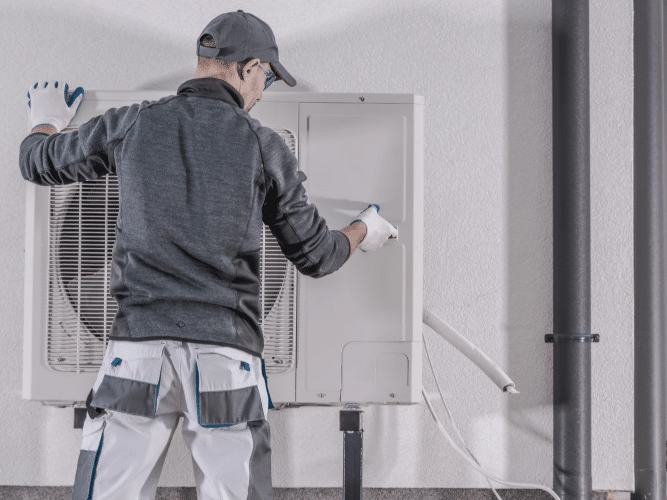
Mechanical issues are another common reason for an AC fan not working. These problems often involve moving parts of the system that can wear down or break over time.
Worn Bearings
Bearings in the fan motor can wear out, causing the motor to seize. This prevents the fan from spinning and requires the replacement of the affected bearings to restore function.
Blocked Air Filter
A clogged air filter can restrict airflow, causing the fan to work harder and potentially overheat. Regularly replacing the air filter ensures efficient operation and prevents mechanical strain.
Belt Problems
In systems that use a belt-driven fan, the belt can become loose or break, potentially causing issues. Inspecting and replacing the belt can resolve the issue and restore the fan’s functionality.
Regular maintenance and inspections can help identify these mechanical issues early, preventing more significant problems and ensuring the longevity of the AC system.
Checking the Thermostat Settings of the AC Fan
The thermostat serves as the control center for your air conditioning system, and incorrect settings can cause the AC fan to malfunction. Ensuring the thermostat is functioning correctly is an essential step in troubleshooting.
1. Correct Mode and Temperature
Verify that the thermostat is set to the “cool” mode and that the temperature is set lower than the current room temperature. This simple check can quickly resolve operational issues.
2. Programmable Thermostat Settings
If you have a programmable thermostat, ensure that the schedules align with your desired cooling times. Incorrect programming can cause the fan not to operate as expected.
3. Thermostat Placement
The location of the thermostat can affect its functionality. If it’s placed in direct sunlight or near heat sources, it may not provide accurate readings, which can lead to improper fan operation.
By regularly checking and adjusting thermostat settings, you can ensure that your AC system operates efficiently and effectively, maintaining a comfortable indoor environment.
When to Call a Professional
If your AC fan still doesn’t work after basic troubleshooting, it’s a sign you need expert help. A trained technician can quickly diagnose the actual issue. Professional HVAC repair ensures your cooling system is safely restored and runs properly without risking further damage or costly mistakes.
Electrical issues, such as faulty wiring or defective capacitors, should never be handled without proper training and expertise. These repairs can be risky without the right tools and experience. Hiring a licensed technician helps protect your home and ensures the job is done correctly, preventing additional electrical problems down the road.
Replacing a burnt-out fan motor is not a simple repair. It requires the correct replacement part, careful installation, and a solid understanding of how your AC system works. A professional will make sure the new motor fits properly, runs efficiently, and helps extend your unit’s overall life.
Preventive Maintenance for Your AC Fan
Preventive maintenance is essential in avoiding issues with an AC fan not working. Regular care and attention can prolong the life of your air conditioning system and enhance its performance.
1. Regular Inspections
Schedule routine inspections to identify and address any potential problems before they escalate. This can include checking wiring, cleaning fan blades, and inspecting the motor.
2. Filter Replacement
Change the air filter every 1-3 months, depending on usage and the manufacturer’s recommendations. A clean filter ensures efficient airflow and reduces strain on the fan.
3. Professional Servicing
Engage a professional for annual maintenance checks. They can perform thorough cleanings, inspect the system’s components, and make necessary adjustments to keep the AC running smoothly.
By adhering to a regular maintenance schedule, you can prevent unexpected breakdowns and maintain a comfortable indoor environment throughout the year.
Frequently Asked Questions
Why isn't my AC fan turning on?
If your AC fan is not turning on, it could be due to a faulty thermostat, a blown capacitor, or electrical issues. Always check the power source and settings first. If that doesn’t resolve the issue, consider calling a professional for HVAC troubleshooting.
How do I clean the AC fan blades?
Turn off the power to the unit before cleaning. Remove the fan cover, then use a damp cloth to gently wipe down each blade and remove dirt. Dust and debris reduce airflow, so keeping them clean helps your system run better and keeps cool air flowing.
Can a tripped circuit breaker make the AC fan stop working?
Yes, a tripped circuit breaker can shut off power to your AC fan, causing it to stop completely. Without power, the fan cannot operate. Reset the breaker once, but if it keeps tripping, you may need professional HVAC repair to fix the root issue.
What is the typical cost to replace an AC fan motor?
Replacing an AC fan motor usually costs between $300 and $700, including labor. The cost depends on the specific motor and the type of air conditioning unit you have. Regular maintenance can help prevent costly motor failure and extend the life of your air conditioner.
How do I test the AC fan motor with a multimeter?
To test the AC fan motor with a multimeter, turn off the power and disconnect the motor from the power source. Use the meter to check for continuity across terminals. If there’s no reading, the motor is likely bad and should be replaced by an HVAC technician.
Conclusion
If your AC fan is not working, don’t wait until it gets worse. A minor issue can quickly escalate into a major repair if left unattended for too long. Understanding how your system works and knowing the warning signs can help you stay one step ahead of the heat.
Some fan problems are easy to fix, while others require expert care. That’s where our team at AC Repair DFW comes in. We offer trusted HVAC repair services in Euless, TX, to ensure your system runs safely and efficiently, regardless of the season or temperature.
Ready to take action? Let us help you get your cool air back fast. Contact AC Repair DFW today to schedule an inspection or arrange repairs with our certified technicians. We will repair the problem, walk you through what caused it, and provide tips to prevent it from recurring in the future.
End Note
Looking for fast, reliable help with your AC or heating system? Visit AC Repair DFW to explore all the ways we keep homes and businesses comfortable year-round. From expert HVAC services to full HVAC installation & replacement, we’ve got every corner of your indoor comfort covered.
If your unit isn’t working right, don’t sweat it—our HVAC repair team is just a click away. Want to improve your energy savings? Try our energy assessment and structure energy review services. We will help you identify hidden issues, reduce utility costs, and extend the life of your system.
Stay ahead of breakdowns with our HVAC maintenance plans, tailored for residential and commercial systems. Learn more about us, view our projects, or read the latest valuable tips on our blog. Follow us on Facebook for more updates, and Contact Us directly to schedule service today.


